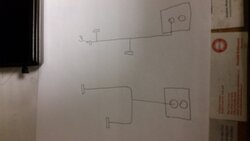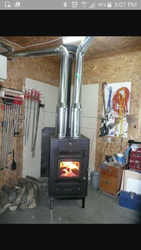Hello folks..1100 square foot bungalow with basement..was wondering if you can put a tee on the the two 8 inch outlets after running the 8 inch duct work for a few feet the putting in the tees and have 4 floor registers that way or is it better to run each 8inch outlet straight to their own floor registers (kitchen and living room). I plan on running 8inch Duct work for about 6-8feet then reducing it to 6inch. Thanks
drolet tundra install
- Thread starter barryh
- Start date
-
Active since 1995, Hearth.com is THE place on the internet for free information and advice about wood stoves, pellet stoves and other energy saving equipment.
We strive to provide opinions, articles, discussions and history related to Hearth Products and in a more general sense, energy issues.
We promote the EFFICIENT, RESPONSIBLE, CLEAN and SAFE use of all fuels, whether renewable or fossil.
You are using an out of date browser. It may not display this or other websites correctly.
You should upgrade or use an alternative browser.
You should upgrade or use an alternative browser.
- Status
- Not open for further replies.
brenndatomu
Minister of Fire
Howdy barry! So you are going up with the (2) 8" ducts, then tee them off into (4) runs at the ceiling? That sounds OK but I would run the 8" as far as you can and then reduce to 6" toward the end of the run, closer to the registers. You'd be surprised how much air the blower still moves even on low, don't wanna restrict things too much. Plus it is always good to have "oversized" ducts in the event of a power failure, they'll carry more heat by gravity.
Post up some pics when you get done
Post up some pics when you get done

brenndatomu
Minister of Fire
Yeah, it should work good, that is basically how I did my sisters ductwork on their Tundra, only I used (4) runs of 7" pipe, mainly because that's what was there from before. 2 runs upstairs, 1 to a basement bedroom and 1 dumps to the basement rec room...seems fine
brenndatomu
Minister of Fire
The top one. Go 8" for the main run and then 6" for the take offs. Put dampers in too so you can balance the airflow and set your static pressure...
brenndatomu
Minister of Fire
Oh, and get the better dampers with a pivot point on each side, they are only like $.50 more than the single sided ones, and much more sturdy
DoubleB
Minister of Fire
Which way do you think would be the best way to run the duck work.?
@brenndatomu is the bomb in my book, although to the extent that your sketch is accurate, I'd vote for the bottom sketch. My thinking is:
-blowing the air straight into the tee in the bottom sketch balances pressure between the two take-offs, whereas blowing the air sideways through the tee in the top sketch puts more pressure/flow on the left take-off and less pressure/flow into the lower take-off. Of course you could crank the damper shut more on the left take-off, but in general it promotes better airflow through the whole system if the take-offs can be as balanced as possible by design alone, leaving less compensating for the dampers, and better airflow in a power outage.
-The top one has a 90 elbow that the full air flow blows through. That's more flow resistance than the bottom drawing where 1/2 the airflow blows through the 90's (assuming it's all 8" pipe for the 90's).
I'm sure there's much more involved in your house than a stick-figure sketch, but those are just some things that came to my mind.
STIHLY DAN
Minister of Fire
Bobthe
New Member
I'll be picking up my new Tundra this Friday. Instead of two 8" pipes transporting heat into the house from the basement, I have 12' of 8"x16" rectangular duct running horizontal, then the same size runs vertical into the middle of the house where it has four 6" round ducts going straight to registers.
Will I have any issues connecting the two 8" round ducts from the furnace to the rectangular duct? Will I need to add or modify anything?
Will I have any issues connecting the two 8" round ducts from the furnace to the rectangular duct? Will I need to add or modify anything?
brenndatomu
Minister of Fire
Shouldn't be an issue, I ran the (2) 8" round ducts straight up into the existing rectangular ducts myself
brenndatomu
Minister of Fire
It's definitely not ideal but you can always try it and see. I personally would worry about the blower having too much static pressure and not being able to cool the firebox when she's cranked up good. The further you can run 8" the better, and if you have to go down to 6", it takes (4) 6" pipes to flow the same (roughly) as (2) 8"Would it be any problem if I reduces down to 6" after only a couple horizontal feet of 8 inch duct?
How far is it to the wall? IIRC, you can run a max of 10' horizontally if the pipe runs uphill and is supported every 3'And can I have the double wall stove pipe coming straight out of the back of furnace threw the concrete wall....with no 45s just straight threw the tee in the concrete wall? Thanks
You need at least 1/4" of rise per foot of run on that pipe (that's an absolute minimum, more is better)
OK I was just wondering because I got little over 6 feet to my roof trusses and didn't really want to have big 8 inch duct in the way...and I plan on just having the back of the furnace a few inches from the concert wall...so I guess maybe 18 inches of stove pipe coming from back of furnace straight to the tee......or is it better to use two 45 degree elbows and move the tee up a bit from the flue outlet on back of furnace?
brenndatomu
Minister of Fire
I guess I'd tend to use (2) 45s and move the chimney up, so that if you ever wanted to install a taller furnace you can without too much trouble
brenndatomu
Minister of Fire
As long as everything connects up properly and the CTC (clearance to combustibles) are met, should be OK for that short run. I am assuming you are connecting into a new class A chimney?OK thanks....but if I decide to go straight into the tee.....it will be alright that way will it?
Bobthe
New Member
Hey barryh,
Are you installing a barometric damper on your flue?
I was reading the online version of the manual for this unit, and will definitely be installing one on mine when I pick it up this Friday. I also picked up a manometer to determine the air flow up the flue.
I need to get a thermostat, but haven't decided what would be best. The area being heated is a 70 year old, 900 sqft. cabin with no insulation in the walls and only about 4" of fiberglass in the attic. Any advice is welcome.
I've found this forum to be the best resource on the net selecting and getting a good install on a new wood furnace. Super-glad I found it. I was initially going to get a Hotblast unit from TSC, but as soon as I read some of the posts that mentioned the Drolet Tundra, I immediately changed my mind. I had never heard of the company until now. Elated that I joined this site.
I've heated with wood my whole life, but have been doing it the low-tech, poorly sealed wood stoves and a flue damper. I've been telling my hillbilly older brother and some friends about installing a barometric damper and manometer on the new woodstove/furnace, and I get the usual deer in the headlights look and all I hear are the crickets chirping in the background.
Are you installing a barometric damper on your flue?
I was reading the online version of the manual for this unit, and will definitely be installing one on mine when I pick it up this Friday. I also picked up a manometer to determine the air flow up the flue.
I need to get a thermostat, but haven't decided what would be best. The area being heated is a 70 year old, 900 sqft. cabin with no insulation in the walls and only about 4" of fiberglass in the attic. Any advice is welcome.
I've found this forum to be the best resource on the net selecting and getting a good install on a new wood furnace. Super-glad I found it. I was initially going to get a Hotblast unit from TSC, but as soon as I read some of the posts that mentioned the Drolet Tundra, I immediately changed my mind. I had never heard of the company until now. Elated that I joined this site.
I've heated with wood my whole life, but have been doing it the low-tech, poorly sealed wood stoves and a flue damper. I've been telling my hillbilly older brother and some friends about installing a barometric damper and manometer on the new woodstove/furnace, and I get the usual deer in the headlights look and all I hear are the crickets chirping in the background.
STIHLY DAN
Minister of Fire
But 2 45's will work better. Personally I think short cuts on wood heat tend to not be worth it.As long as everything connects up properly and the CTC (clearance to combustibles) are met, should be OK for that short run. I am assuming you are connecting into a new class A chimney?
brenndatomu
Minister of Fire
Don't forget to leave enough room to get the filter out if you are gonna use one, (highly recommended) they come out the back if you put it on the side...maybe 18 inches of stove pipe coming from back of furnace straight to the tee
The Honeywell FocusPro 5000 is cheap enough and works well with wood furnaces. You can pick 'em up for ~$20 on fleabay...I need to get a thermostat, but haven't decided what would be best
Last edited:
- Status
- Not open for further replies.
Similar threads
- Replies
- 6
- Views
- 783
- Replies
- 13
- Views
- 918
- Replies
- 1
- Views
- 436
- Replies
- 36
- Views
- 3K



